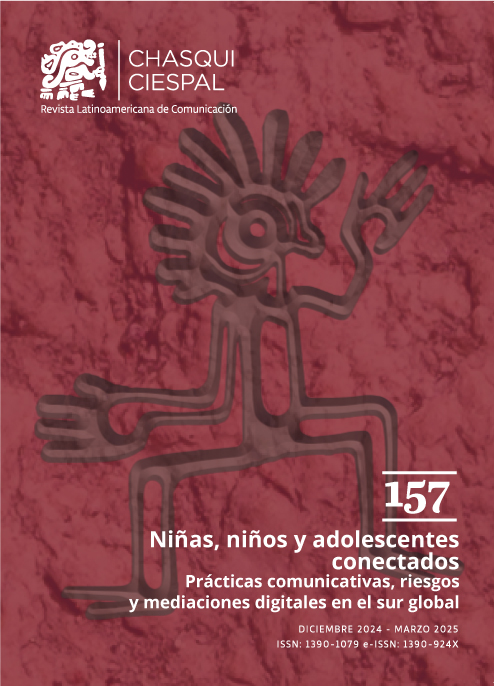Alfabetización digital y aprendizaje autónomo. La pronunciación de consonantes oclusivas sordas con English Accent Coach
DOI:
https://doi.org/10.16921/chasqui.v1i157.5062Keywords:
alfabetización digital, aprendizaje autónomo, English Accent Coach, oclusivas sordas.Abstract
Este estudio experimental examina la relación entre la alfabetización digital y el aprendizaje autónomo en la pronunciación de las consonantes oclusivas sordas /p, t, k/ en inglés, utilizando la plataforma English Accent Coach. Diez estudiantes de instituciones educativas públicas, de entre 13 y 15 años, participaron en un pretest, tratamiento y posttest, donde se grabaron producciones de palabras monosilábicas. El enfoque metodológico incluyó el análisis acústico de la aspiración mediante espectrogramas en el programa PRAAT. Los resultados sugieren que la herramienta digital contribuye a la mejora de la producción de la aspiración en estos fonemas y que además la incorporación de herramientas digitales promueve el desarrollo de habilidades de alfabetización digital como el trabajo autónomo.References
Alfia, N., Sumardi, S., & Kristina, D. (2021). Integrating Digital Literacy Into EFL Classroom: A Study of Theory of Planned Behavior. JPI (Jurnal Pendidikan Indonesia), 10(3), 535. https://doi.org/10.23887/jpi-undiksha.v10i3.29812
Arias Soto, L. D., & González Gutierrez, Y. A. (2019). Digital Literacy and Basic Self-Regulation Habits in Early Childhood Learning of English as a Foreign Language. Folios, 49, 177–196. https://doi.org/10.17227/folios.49-9404
Benson, P. (2007). Autonomy in language teaching and learning. Language Teaching, 40(1), 21–40. https://doi.org/10.1017/S0261444806003958
Celce-Murcia, M. (1994). Teaching Pronunciation for Communication: The second time around. MEXTESOL Journal, 18. https://www.mextesol.net/journal/index.php?page=journal&id_article=1155
Dewi, G. P., Dwi, G., & Anellysha, D. (2021). Journal of English Language Teaching “Success is in your hand”: Digital literacy to support students’ autonomous learning in speaking class. Journal of English Language Teaching, 6(1). http://journal.unnes.ac.id/sju/index.php/elt
Education First. (2023). English Proficiency Index: a Ranking of 113 Countries and Regions by English Skills. www.efset.orgwww.ef.com/epi
Gordon, J. (2022). Making the Teaching of Segmentals Purposeful. In
J. Levis, T. Derwing, & S. Sonsaat - Hegelheimer (Eds.), Second Language Pronunciation: Bridging the Gap Between Research and Teaching (pp. 61–84). WILEY Blackwell.
Instituto Nacional de Estadistica y Censos. (2024). Tecnologías de la información y comunicación. https://www.ecuadorencifras.gob.ec/sociedad-de-la-informacion/
Kiryakova, G., Angelova, N., & Yordanova, L. (2017). GAMIFICATION IN EDUCATION. International Balkan Education and Science Conference.
Levis, J., & Echelberger, A. (2022). Integrating Prounciatio into Language Istruction. In J. Levis, T. Derwing, & S. Sonsaat - Hegelheimer (Eds.), Second Language Pronunciation: Bridging the Gap Between Research and Teaching (pp. 19–41). WILEY Blackwell.
Levis, J. M., Derwing, T. M., & Munro, M. J. (2023). The Evolution of Pronunciation Teaching and Research (J. Levis, T. Derwing, & M. Munro, Eds.; Vol. 121). John Benjamins Publishing Company. https://www.ebsco.com/terms-of-use
Liu, Y., & Chang, P. (2024). Exploring EFL teachers’ emotional experiences and adaptive expertise in the context of AI advancements: A positive psychology perspective. System, 126. https://doi.org/10.1016/j.system.2024.103463
Machado, J. (2024, September 2). Todas las materias y horas de clase que tendrán los estudiantes del año lectivo 2024-2025 en Ecuador.
Ministerio de Educacion. (2021). Agenda Educativa Digital 2021 - 2025. www.educacion.gob.ec
Nicholas, H., & Wan, N. (2019). Mobile Digital Literacy of Australian Adolescent Students. International Journal of Digital Literacy and Digital Competence, 10(3), 32–48. https://doi.org/10.4018/ijdldc.2019070103
Pratiwi, D. I., & Waluyo, B. (2023). Autonomous learning and the use of digital technologies in online English classrooms in higher education. Contemporary Educational Technology, 15(2). https://doi.org/10.30935/cedtech/13094
Rahmani, E. F. (2020). The Benefits of Gamification in the English Learning Context. IJEE (Indonesian Journal of English Education), 7(1), 32–47. https://doi.org/10.15408/ijee.v7i1.17054
Swan, Michael., & Smith, Bernard. (2013). Learner English : a teacher’s guide to interference and other problems. Cambridge University Press.
Tazijan, F., Aboo, R., & Mohd, N. (2022). The Drive of Digital Literacy Skills in the 21 st Century. International Journal of Practices in Teaching and Learning, 2(1). https://www.thestar.com.my/lifestyle/family/2020/11/20/barriers-
Thomson, R. (2016). English Accent Coach Title English Accent Coach Author. The Electronic Journal for English as a Second Language, 20(1), 1–8. http://www.englishaccentcoach.com/
Thomson, R. (2018). High Variability [Pronunciation] Training (HVPT) A proven technique about which every language teacher and learner ought to know. Journal of Second Language Pronunciation, 208–231. https://doi.org/io.io75/jslp.i7038-tho
Thomson, R. (2022). Perception in Pronunciation Training. In J. Levis, T. Derwing, & S. Sonsaat. - Hegelheimer (Eds.), Second Language Pronunciation: Bridging the Gap Between Research and Teaching (pp. 42–60). WILEY Blackwell.
Wan, N. (2012). Can we teach digital natives digital literacy? Computers and Education, 59(3), 1065–1078. https://doi.org/10.1016/j.compedu.2012.04.016
Wan, N. (2015). Digital Literacy: The Overarching Element for Successful Technology Integration. In New Digital Technology in Education (pp. 125–145). Springer International Publishing. https://doi.org/10.1007/978-3-319-05822-1_6
Yavaş, M. (2011). Applied English Phonology. Wiley. https://doi.org/10.1002/9781444392623
Zeng, W. (2023). An Investigation into Digital Literacy and Autonomous Learning of High School Students. English Language Teaching, 16(2), 131. https://doi.org/10.5539/elt.v16n2p131
Downloads
Published
Issue
Section
License
- Authors retain copyright and grant the journal right of first publication with the work simultaneously licensed under a Creative Commons Attribution-NoDerivs License (CC BY-ND) that allows others to share the work with an acknowledgement of the work's authorship and initial publication in this journal.
- Authors are able to enter into separate, additional contractual arrangements for the non-exclusive distribution of the journal's published version of the work (e.g., post it to an institutional repository or publish it in a book), with an acknowledgement of its initial publication in this journal.
- Authors are permitted and encouraged to post their work online.

